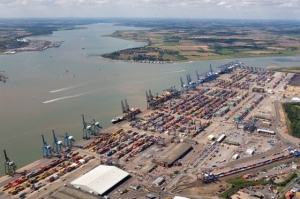A visit to a jetty at the little port of Harwich on England’s east coast, facing the North Sea, is a good place to get a glimpse of the modern global shipping industry’s enormous scale. From this vantage point the much bigger Felixstowe port on the opposite bank of the River Orwell can be seen in panoramic view in all its glory: bustling activity along the waterfront with a long line of huge container ships loading and discharging.

Even for maritime professionals well-acquainted with this shipping sector, it is an impressive sight, underlining the vastness of international seaborne trade in containerised goods of all sorts and varieties. But only a small part of the population sees this vital maritime activity at Felixstowe or elsewhere in ports around the world and, among those who do, many will be blissfully unaware of its true significance. Mostly these ships, and indeed other vessel types, and the ports which serve them, are well hidden from public view in remote locations.
That is why a new book by Rose George published last year, entitled ‘Deep Sea and Foreign Going’, provides a valuable contribution to understanding the importance of this obscured-from-view industry. The author’s voyage on a container ship from the UK to Asia is the setting. In particular, the narrative offers a fascinating insight into the working lives of the people who make it happen, the seafarers.
Clearly described is the difficult and, at times, potentially very dangerous environment in which seafarers not only work but totally exist for periods of many months while employed on long-distance voyages. There is no escape from the working environment while a ship is at sea (virtually all the time). These circumstances are not comprehended by most users of the goods which the ships transport. Many consumers have no idea how electrical or electronic devices, for instance, get to the shops from the manufacturers in China, Korea or other origins. Some think it all arrives by air freight. There is even less understanding of what seafarers have to encounter, and their separation indeed isolation from the civilised world, living in a small and sometimes not very sociable closed community, while serving at sea for extended periods.
Despite these features, Rose George acknowledges on page 9 that “seafaring can be a good life”. Another acknowledgement is that “most ship owners operate decent ships that are safe, and pay their crews properly” (page 86). On the other hand, some owners hide behind a flag of the open registry variety and cut corners, which can lead to disasters for both ship and crew. And, disturbingly, in concluding comments on page 265, the author quotes the master of the container ship on which she travelled as saying that the crew are “mere chattels, a human resource, dispensible non-entities”. This opinion is not exactly a ringing endorsement of comfortable relationships between managements and seafarers.
It is a highly readable book, quite gripping in parts, written in an easy-going style. Ignoring some lengthy deviation about a ship rescue in the second world war, and whale preservation in the northeastern USA, it serves a useful purpose. But as an educational exercise, for the general public, presumably the author’s aim as a piece of ‘investigative journalism’, much more could have been said about the global container shipping industry. A few short paragraphs of miscellaneous and not especially helpful industry statistics, as background, are insufficient to provide meaningful context.
One essential fact, which could have been included as contextual information for the aspects identified during the voyage, is that container ships now comprise 13 percent of the world fleet of all cargo vessels, a fleet including many other important ship types. Another is that container ships numbered 5,106 at the end of 2012, with a capacity of 16.2 million teu (twenty foot equivalent units, the standard measurement), based on data from Clarksons Research. Container ship fleet growth over the preceding decade was 168 percent and capacity continues to rise. And increasing ship sizes – 18,000 teu leviathans are joining the fleet, compared with vessels only half that size which were the norm only a few years ago – are a feature of progress, ensuring more economical transportation.
Another storyline emphasis might have been the services these ships provide for global manufacturing industry, how container services are organised and why they are so effective and efficient. World seaborne containerised goods shipments are estimated to total over 1.5 billion tonnes per year currently, after almost doubling during the past decade. Ocean freight cost is generally a low proportion of most products’ value. The impact on, and advantages for, the globalisation process are apparent. Many countries have been integrated into the global trading system when previously they were on the fringes, if participating at all.
None of the foregoing maritime achievements are satisfactorily set out in ‘Deep Sea and Foreign Going’. Arguably, such a preliminary discussion is required for a balanced view to be offered. Nevertheless, the book certainly has great merit in opening eyes to the stark realities of seafarers’ lifestyles and, frequently, the lack of attention paid to this noble profession. Many spectators standing on the remote Essex jetty watching the impressive ships coming and going could gain a useful perspective by reading it.
Richard Scott, Visiting Lecturer, Greenwich Maritime Institute and MD, Bulk Shipping Analysis

